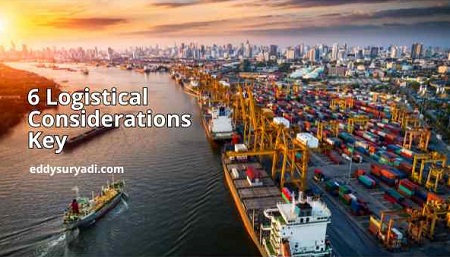Logistics plays a pivotal role in modern businesses, influencing everything from supply chain efficiency to customer satisfaction. The process of managing the flow of goods, information, and resources from origin to destination requires careful planning and execution. Whether you are setting up a small business or managing a global operation, understanding logistical considerations is critical to success. This article delves into the key factors that businesses must consider to ensure a seamless and cost-effective logistics operation.
What Are Logistical Considerations?
Logistical considerations refer to the various factors and decisions involved in planning, implementing, and controlling the movement and storage of goods. These include transportation, warehousing, inventory management, packaging, and information flow. Each element is interdependent, requiring a coordinated approach to optimize efficiency and reduce costs.
The Importance of Logistics in Business
Effective logistics management offers numerous benefits, such as:
- Cost Savings: Streamlined logistics can reduce transportation and storage costs.
- Customer Satisfaction: Timely and accurate deliveries enhance customer loyalty and trust.
- Competitive Advantage: Businesses with efficient logistics can outperform competitors in speed, cost, and reliability.
- Risk Mitigation: Proper planning minimizes disruptions caused by supply chain issues, natural disasters, or market fluctuations.
- Sustainability: Efficient logistics can reduce the environmental impact by optimizing resource use and minimizing waste.
Key Logistical Considerations
1. Transportation
Transportation is the backbone of logistics, encompassing the movement of goods by land, sea, air, or rail. Key considerations include:
- Mode of Transport: Choose the most suitable mode based on factors like cost, speed, distance, and product type.
- Route Optimization: Identify the most efficient routes to reduce transit time and fuel costs.
- Carrier Selection: Partner with reliable carriers that offer competitive rates and consistent service.
- Freight Management: Ensure proper handling of goods to prevent damage during transit.
2. Warehousing
Warehousing involves storing goods before they are distributed to customers. Considerations include:
- Location: Warehouses should be strategically located near suppliers or customers to minimize transportation costs.
- Storage Systems: Use appropriate storage solutions, such as shelving, pallet racks, or automated systems, based on product requirements.
- Inventory Control: Implement systems to track stock levels, reduce holding costs, and prevent overstocking or stockouts.
- Security and Safety: Ensure facilities meet safety standards and have adequate security measures to protect goods.
3. Inventory Management
Efficient inventory management is crucial for meeting demand without overstocking. Key practices include:
- Demand Forecasting: Use historical data and market trends to predict demand accurately.
- Just-in-Time (JIT) Inventory: Minimize inventory levels by aligning production and procurement with actual demand.
- ABC Analysis: Categorize inventory based on value and turnover to prioritize high-impact items.
- Safety Stock: Maintain buffer stock to handle demand fluctuations or supply chain disruptions.
4. Packaging and Handling
Packaging protects goods during transit and handling. Key considerations include:
- Material Selection: Use durable and sustainable materials to minimize damage and environmental impact.
- Product-Specific Needs: Tailor packaging to the specific requirements of the product, such as temperature-sensitive items.
- Cost Efficiency: Optimize packaging design to reduce material costs and shipping weight
- Compliance: Ensure packaging meets regulatory requirements for labeling and safety.
5. Risk Management
Logistics involves various risks that must be proactively managed. Considerations include:
- Supply Chain Disruptions: Develop contingency plans for events like natural disasters, supplier failures, or geopolitical issues.
- Insurance: Insure goods to protect against losses during transit or storage.
- Compliance: Stay updated on regulations related to transportation, customs, and trade.
- Cybersecurity: Protect logistics systems from cyber threats that could disrupt operations.
6. Customer Service
Logistics directly impacts the customer experience. Key considerations include:
- Delivery Speed: Ensure timely delivery to meet customer expectations.
- Order Accuracy: Minimize errors in order fulfillment to avoid customer dissatisfaction.
- Communication: Keep customers informed about order status and provide quick resolutions to issues.
- Returns Management: Streamline the returns process to enhance customer satisfaction and reduce costs.
Steps to Optimize Logistics
- Evaluate Current Operations: Identify strengths and weaknesses in your existing logistics processes.
- Set Clear Objectives: Define measurable goals, such as reducing delivery times or cutting transportation costs.
- Invest in Training: Equip your team with the skills and knowledge needed to manage logistics effectively.
- Leverage Technology: Implement tools and systems to automate processes and improve visibility.
- Monitor Performance: Track KPIs like delivery accuracy, inventory turnover, and transportation costs to measure success.
- Continuously Improve: Use data-driven insights to identify areas for improvement and adapt to changing market conditions.
Logistics is a crucial part of business operations. By focusing on key areas like transportation, warehousing, inventory management, and sustainability, businesses can streamline processes, cut costs, and enhance customer satisfaction. Whether you’re starting out or refining your approach, a strategic approach ensures long-term success.
That’s all from me. I hope you find this valuable and insightful!
“Simplifying Supply Chains, Empowering Teams, Driving Success – Eddy Suryadi”
*Feel free to share this article with your network to help them gain valuable insights as well. For more tips and updates on supply chain management, don’t forget to connect with me on LinkedIn. Please note that all articles on this blog are available for use—personal or commercial—but must include proper credit to the author.
Originally posted 2024-12-31 06:38:36.
